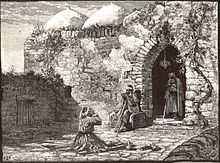Gath-hepher
32°44′30″N 35°19′30″E / 32.74167°N 35.32500°E
Gath-hepher or Gat Hefer (Hebrew: גַּת הַחֵפֶר, romanized: Gaṯ haḤēp̄er) was a border town in the Northern Kingdom of Israel around the 8th century BCE. According to the Deuteronomistic history, it was the home of the prophet Jonah.[1]
History
[edit]
Gath means winepress in Hebrew.[2][3] The town is mentioned twice in the Hebrew Bible, in Joshua 19:13 and 2 Kings 14:25. In Joshua, a copying error has resulted in the form Gittah-hepher.[4]
Jerome in Roman Empire describes the town as "an inconsiderable village" and tells that the tomb of Jonah was nearby.[5] Similarly, the medieval geographer Benjamin of Tudela also relates the tomb of Jonah in his travels to the area.
Today the site, at latitude 32° 44' 30" N and longitude 35° 19' 30" E in the Galilee, is a small set of ruins on a hilltop near the Arab village of Mashhad five kilometres north of Nazareth and one kilometre from Kafr Kanna. The supposed tomb of Jonah is still pointed out by locals.
References
[edit]- ^ 2 Kings 14:25
- ^ "Lexicon Results for Gath-ha-Chepher". Blue Letter Bible. Retrieved 7 August 2012.
- ^ Jerusalem Talmud (Kila'im 9:3; Genesis Rabba § 98:15; not a ruin, per se, but a recognised land feature (e.g. "wine press") known to the ancients as "Gob'batha of Sepphoris," situate some 3 biblical miles from Sepphoris. Marcus Jastrow explains "Gob'batha" as meanings "hills". In J. Payne Smith's A Compendious Syriac Dictionary the word is explained as meaning "a pit, hole, den, cavern." In the Jerusalem Talmud, the name is written in its elided-form, פפתה, instead of גובבתא/גופפתא. The place is said to have been the birthplace of Jonah the prophet.
- ^ Thomas Kelly Cheyne (1901) [1899]. "Gath-hepher". In T. K. Cheyne; J. Sutherland Black (eds.). Encyclopaedia Biblica: A Critical Dictionary of the Literary, Political, and Religious History, the Archaeology, Geography, and Natural History of the Bible. Vol. 2, E–K. New York: The Macmillan Company.
- ^ Ewing, William (1910). The Temple Dictionary of the Bible. London: J. M. Dent & Sons, Ltd. pp. 216.

